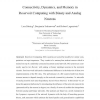128
click to vote
NECO
2010
14 years 11 months ago
2010
Abstract: Reservoir Computing (RC) systems are powerful models for online computations on input sequences. They consist of a memoryless readout neuron which is trained on top of a ...
123
click to vote
NN
2002
Springer
15 years 6 days ago
2002
Springer
This paper presents a biologically-inspired, hardware-realisable spiking neuron model, which we call the Temporal Noisy-Leaky Integrator (TNLI). The dynamic applications of the mo...
127
Voted
JCNS
1998
15 years 6 days ago
1998
An analytical approach is presented for determining the response of a neuron or of the activity in a network of connected neurons, represented by systems of nonlinear ordinary stoc...
147
Voted
NN
2000
Springer
15 years 9 days ago
2000
Springer
The proper functioning of the nervous system depends critically on the intricate network of synaptic connections that are generated during the system development. During the netwo...
109
Voted
NECO
2000
15 years 9 days ago
2000
Recent advances in the technology of multi-unit recordings make it possible to test Hebb's hypothesis that neurons do not function in isolation but are organized in assemblie...
131
click to vote
JCNS
2000
15 years 10 days ago
2000
We explore a computationally efficient method of simulating realistic networks of neurons introduced by Knight, Manin, and Sirovich (1996) in which integrate-and-fire neurons are ...
99
Voted
BC
2000
15 years 11 days ago
2000
We identify generic sources of complex and irregular spiking in biological neural networks. For the network description, we operate on a mathematically exact mesoscopic approach. S...
95
Voted
IJON
2007
15 years 14 days ago
2007
This paper introduces a new model of a spiking neuron with active dendrites and dynamic synapses (ADDS). The neuron employs the dynamics of the synapses and the active properties ...
SIAMAM
2008
15 years 14 days ago
2008
In this paper we define a class of formal neuron models being computationally efficient and biologically plausible, i.e., able to reproduce a wide range of behaviors observed in in...
115
Voted
NN
2006
Springer
15 years 14 days ago
2006
Springer
Neurons in area V 2 and V 4 exhibit stimulus specific tuning to single stimuli, and respond at intermediate firing rates when presented with two differentially preferred stimuli (...





